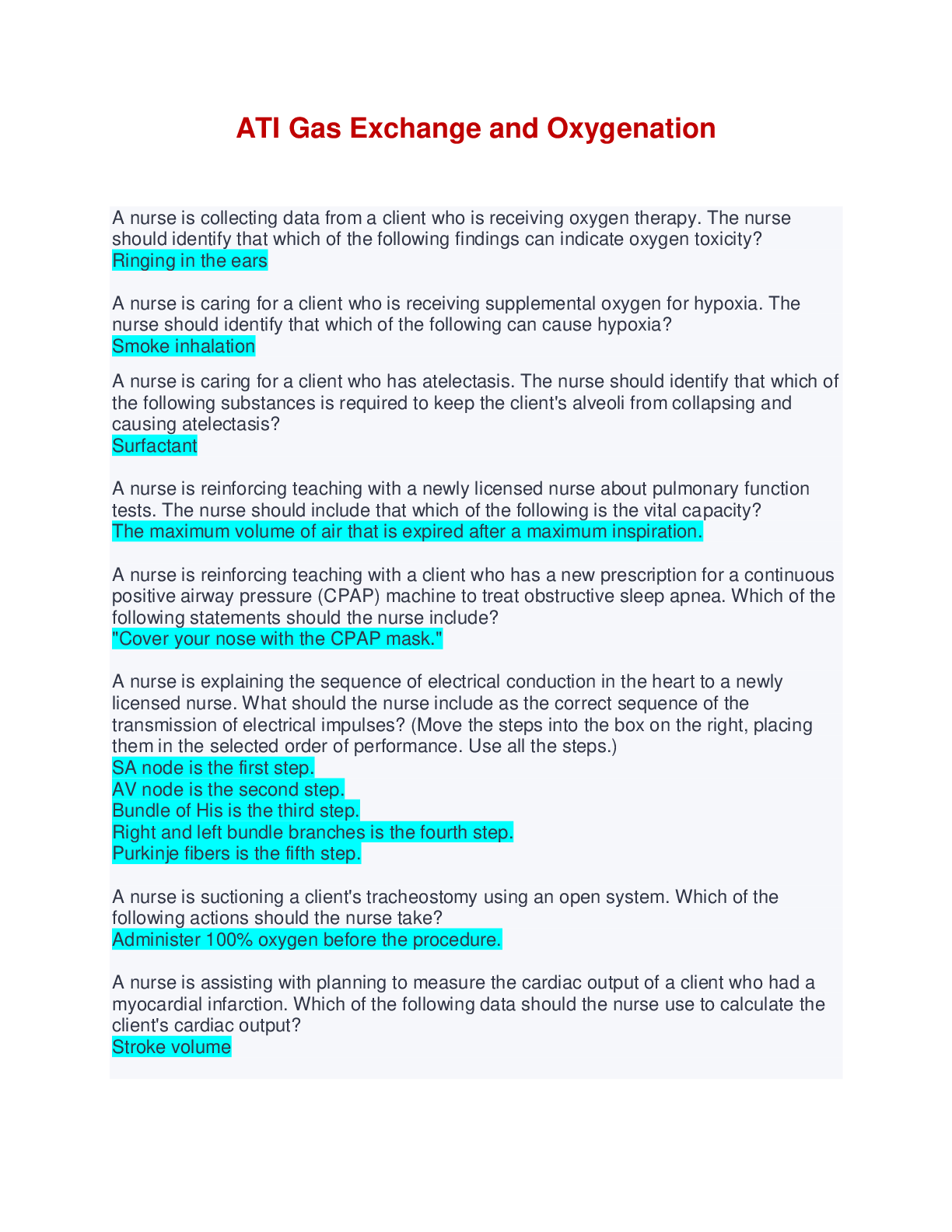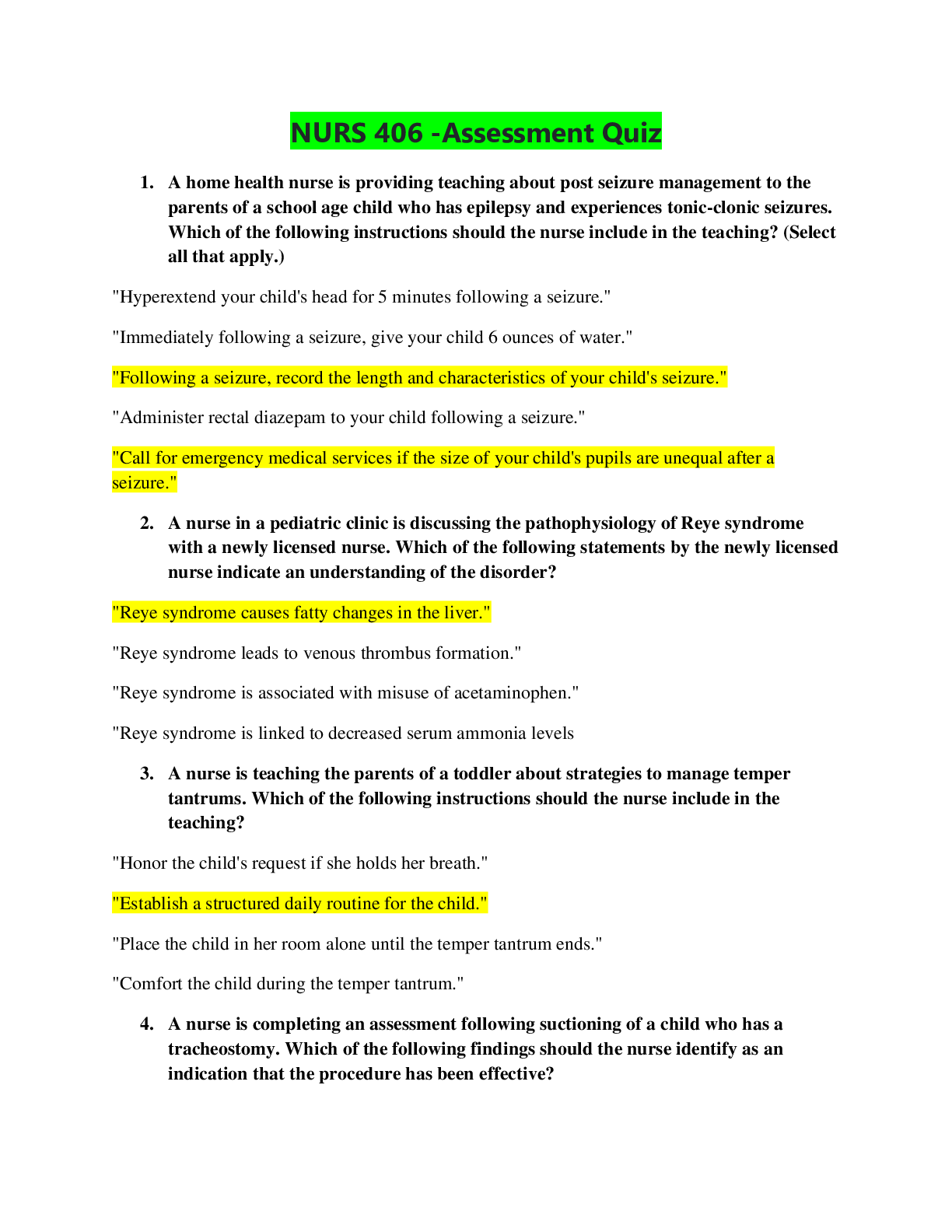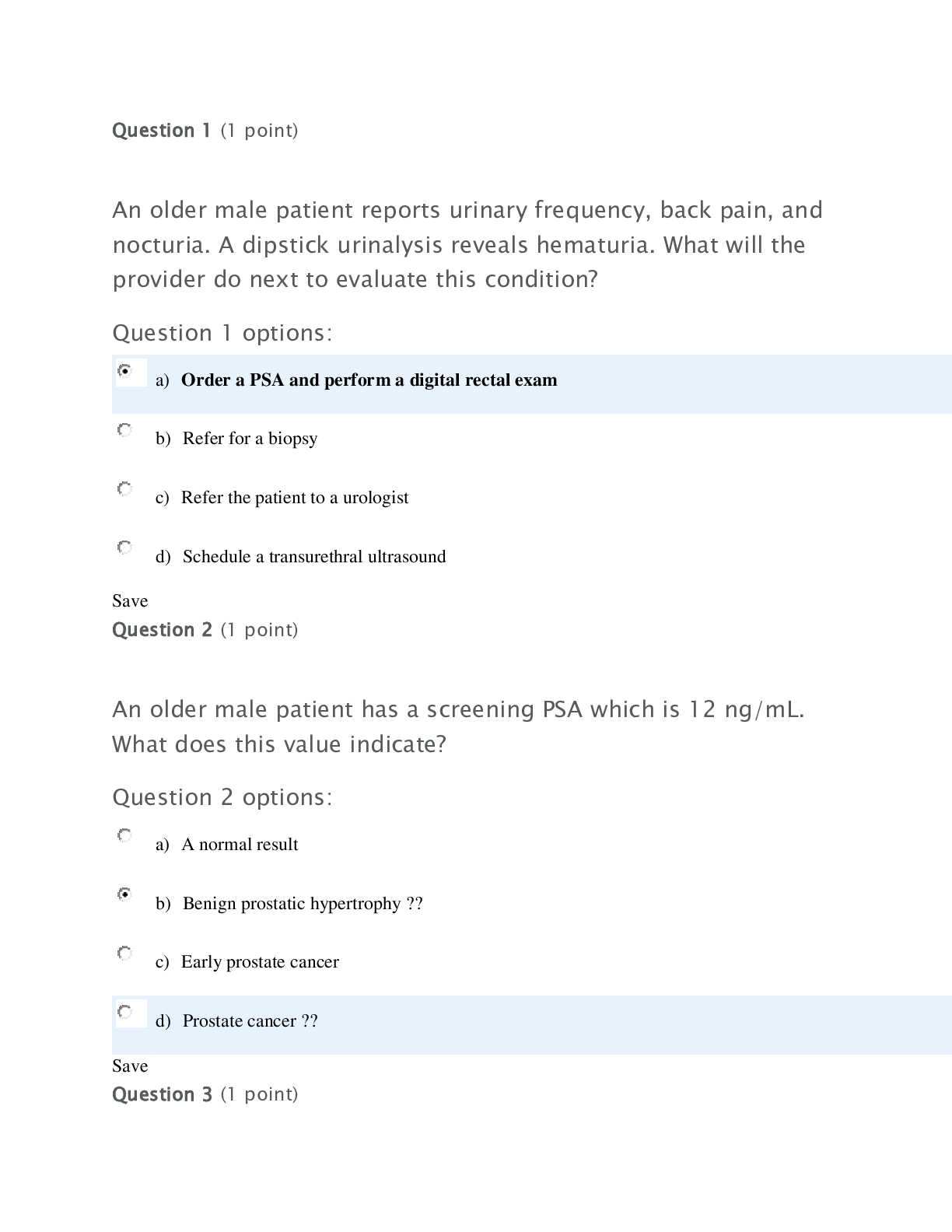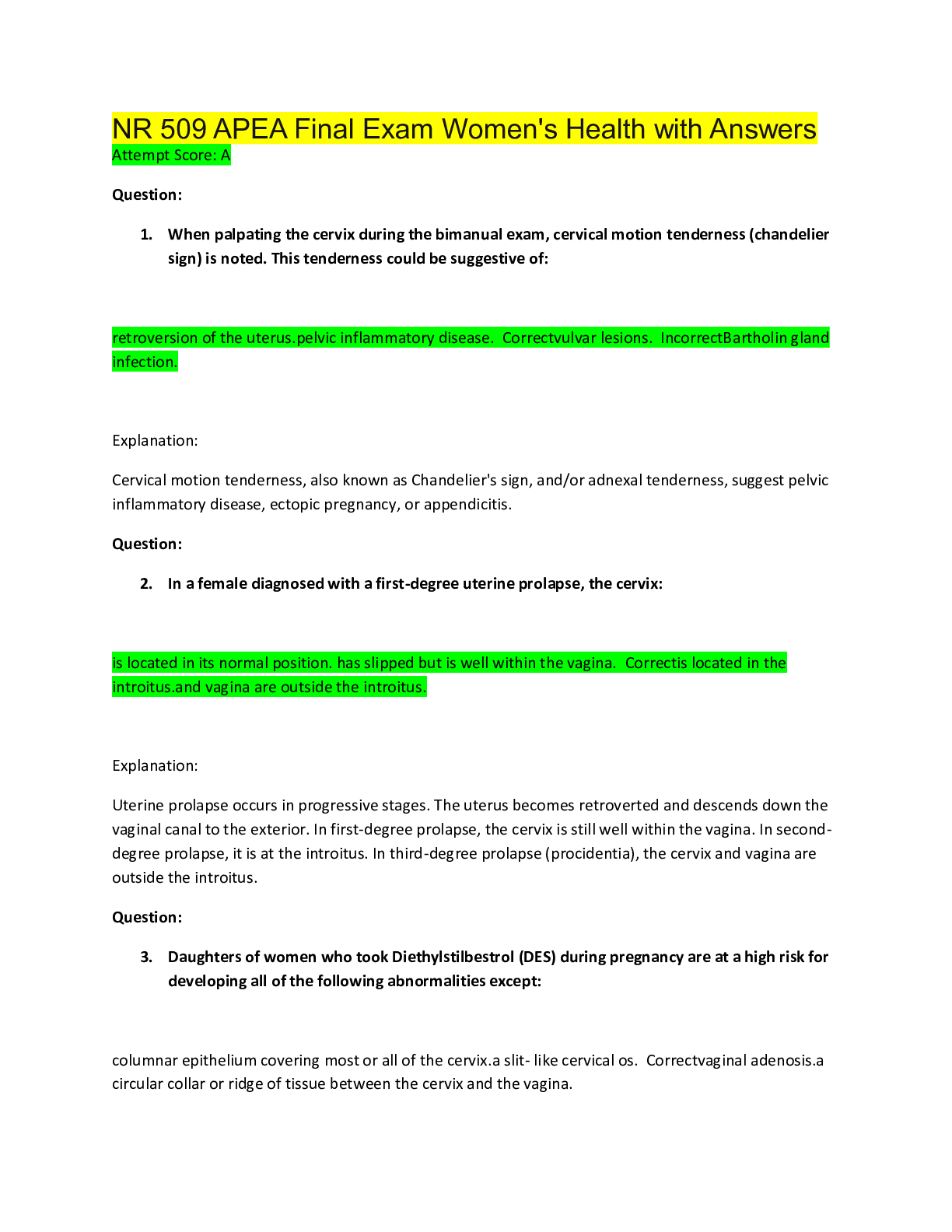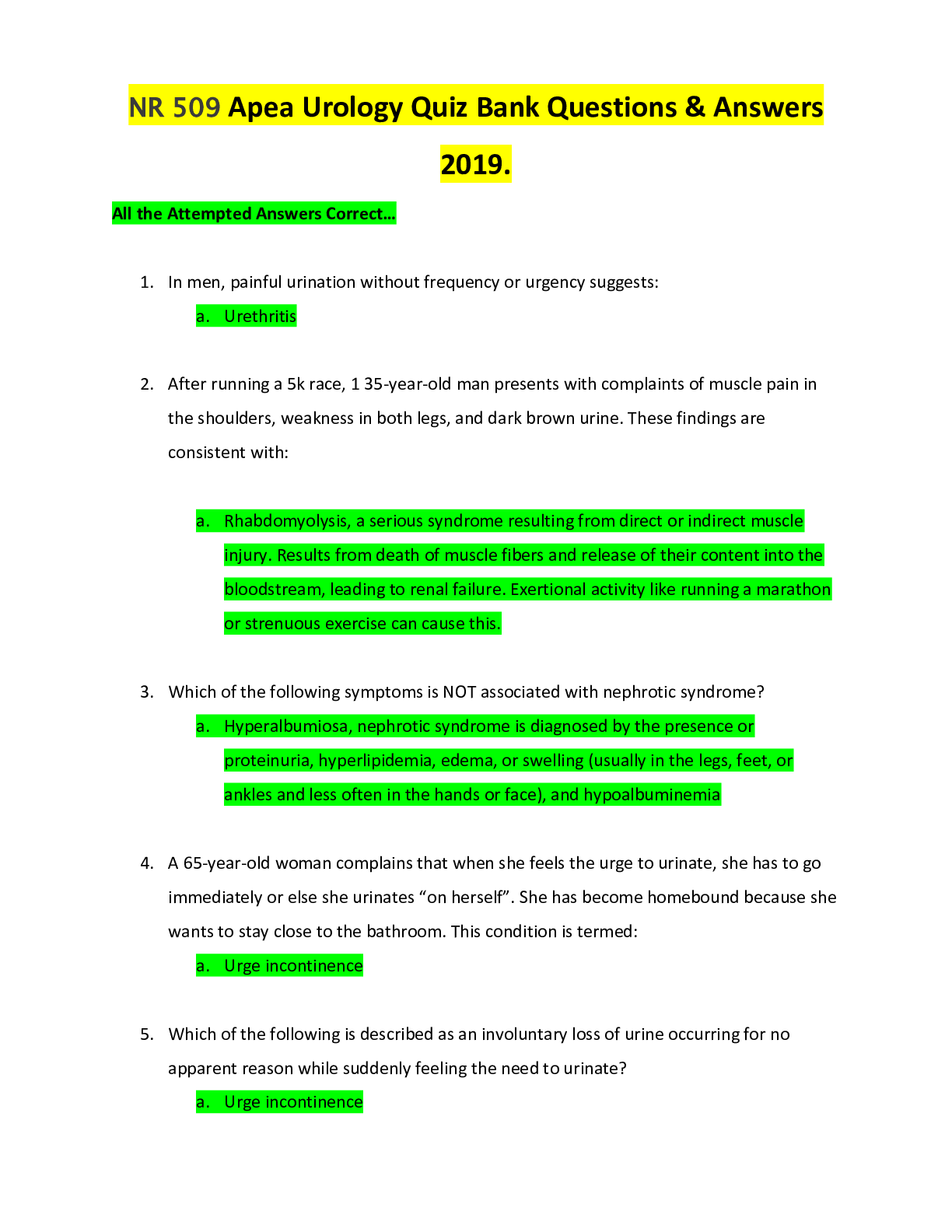*NURSING > EXAM > Chamberlain College of Nursing - NR 509 APEA 3P Exam Week 8 Question and Answers/ Rated A (All)
Chamberlain College of Nursing - NR 509 APEA 3P Exam Week 8 Question and Answers/ Rated A
Document Content and Description Below
NR 509 APEA 3P Exam Study Guide Question 1 A 3 year-old presents with a history of fever and cough over the past 24 hours. Findings on exam reveal: temperature of 102°F, apical heart rate of 157 be... ats/minute, and respiratory rate of 40 breaths/minute. Tachypnea in this child is most likely related to Paradoxical respirations. the child's febrile state. Correct the child's age. an airway obstruction. Question 2 When percussing the lower posterior chest, begin by: standing on the side rather than directly behind the patient. Correct: having the patient lie supine on the examining table. carefully palpating any area the patient has reported pain. using the ball or the ulnar surface of the hand. base of the fingers or the ulnar surface is a technique used to detect tactile fremitus. Question 3 The palpation technique used to assess respiratory expansion of the chest is placing the hands on the eight or tenth ribs posteriorly with the thumbs close to the vertebrae, sliding the hand medially and grasping a small fold of skin between the thumbs. Then: ask the patient to cough and note chest expansion. ask the patient to take a deep breathe and note any delay in expansion during inhalation. Correct have the patient hold his breath for 15 seconds then note chest expansion. have the patient exhale forcefully noting expansion on expiration. Question 4 When trying to differentiate between hemoptysis or blood streaked material, which one of the following observations is correct? Hemoptysis is seen frequently in infants, children, and adolescents with allergic rhinitis. Blood originating in the stomach is usually brighter than blood originating from the respiratory tract. IncorrectHemoptysis is common in children with cystic fibrosis. Correct: Blo Question 5 When percussing the chest in a patient who has left sided heart failure, the sound emanated would be: resonant. Correct dulltympany. Diffusely hyperresonant. Incorrect Question 6 The line that extends through the inferior angle of the scapula when the arms are at the sides of the body is the: mid vertebral line. scapular line. Correct: midclavicular line. mid-spinal line. Question 7 A condition associated with a chronic cough that produces copious amounts of purulent sputum is most likely: tracheobronchitis. chronic bronchitis. Incorrectbronchiectasis. Correct: laryngitis. Question 8 A patient who walked into the examination room, may be observed to be sitting and leaning forward in his chair. Lips were pursed during exhalation and arms are supported on the table. This position could be consistent with patients who have: pneumonia. chronic obstructive pulmonary disease. Correct: asthma. croup. Question 9 Breath sounds heard over the periphery of the lung fields are: bronchial. abnormal. bronchovesicular. Incorrectvesicular. Correct Question 10 When percussing the posterior chest, which one of the following techniques would be omitted? When comparing two areas on the chest, use the same percussion technique in both areas. Percuss one side of the chest then the other at each level. Percuss the areas over the scapulae. Correct: If a louder note is needed, apply more pressure with the pleximeter finger. Question 11 When auscultating breath sounds in a patient who has left sided heart failure, the breath sounds are: vesicular with late inspiratory crackles in the dependent portions of the lungs and resonant on percussion. Correct: bronchial with late inspiratory crackles over the involved area and dull on percussion. vesicular without adventitious sounds and resonant on percussion. Incorrect: decreased with some audible wheezes and diffusely hyperresonant on percussion. Question 12 Breath sounds consisting of a full inspiratory phase and a shortened and softer expiratory phase normally audible over the hilar region of the chest are termed: vesicular.bronchial.bronchovesicular. Correctrhonchi. Question 13 An acute viral illness that presents with a burning retrosternal discomfort and a dry cough is suggestive of: tracheobronchitis. Correctchronicbronchitis. bronchiectasis. laryngitis. Incorrect Question 14 One of the anterior thoracic landmarks is the costal angle. It is located: where the manubrium and body of the sternum intersect. where the right and left costal margins form an angle where they meet at the xiphoid process. Correct: where the suprasternal notch and the sternum form an angle. Incorrectat the angle where the ninth and tenth ribs are fused. Question 15 Atypical respiratory symptoms associated with gastroesophageal disease (GERD) may include all of the following except: coughing.wheezing.aspirationpneumonia.rhinitis. Correct Question 16 On auscultation of the chest, if the patient says "ninety-nine" and it is clearly heard, this is indicative of: a normal sounding chest. Incorrectlung density in the area. Correctconsolidation or compression in the area.of inflammation in the area. Question 17 Respiratory effort in the neonate is initiated at birth as a result of: an increase in the PO2 and a decrease in PCO2. the continued functioning of the foramen ovale. chemical, thermal, and mechanical factors. Correctdrying off the infant. Question 18 Adventitious breath sounds, such as crackles, are: low-pitched, dry, grating sounds heard on inspiration and expiration.continuous, high-pitched, and musical heard on inspiration and expiration. Incorrectcontinuous, low-pitched and prolonged and heard on expiration.popping, frying sounds, may be low or high-pitched and usually heard on inspiration. Correct Question 19 Breath sounds heard on chest over the hilar region are: bronchial.abnormal.bronchovesicular. Correctvesicular. Question 20 Breath sounds consisting of a full inspiratory and expiratory phase with the inspiratory phase usually being louder and normally heard over the trachea and larynx are considered: bronchial. Correctabnormal.bronchovesicular.vesicular. Question 21 Pain from pleurisy may be referred to the: rightshoulder.retrosternal area. Incorrectepigastric area. Correctback. Question 22 When performing a respiratory assessment on a 4-year-old child, further evaluation is warranted in the presence of: the use of the abdominal muscles.eupneicrespirations.supraclavicular retractions. Correctvesicular sounds in the chest periphery. Question 23 Which technique best determines whether the tissues in the chest are air-filled, fluid-filled, or solid? AuscultationPalpationInspectionPercussion Correct Question 24 Breath sounds auscultated over the periphery of the lung fields are quiet and wispy during the inspiratory phase followed by a short, almost silent expiratory phase. These breath sounds are considered: vesicular. Correctbronchovesicular.bronchial. Incorrectcrackles. Question 25 A patient who presents with a long history of cigarette smoking exhibits a dry to productive cough with dyspnea and weight loss. These symptoms could be consistent with: a pulmonary embolus.asthma.a neoplasm of the lung. Correctchronic obstructive pulmonary disease. Incorrect Question 26 The hilar region of the lungs describes: the area around the heart. Correctthe base of the lungs.the posterior chest.the upper, anterior area of the chest. Incorrect Question 27 The anterior surface landmark on the thorax that is denoted by a hollow U-shaped depression just above the sternum and between the clavicles is termed the: sternum.suprasternal notch. Correctsubsternalnodule.spinous process. Question 29 Factors that aggravate costochondritis may include: hypertension. emotionalstress. swallowing cold foods. Incorrect movement of the chest, trunk, and arms. Correct Question 30 To locate the twelfth rib, palpate: anteriorly at the costal margin. between the spine and the lateral chest. Correct: at the tip of the scapula. below the eleventh spinous process. Question 31 To document chest findings located between the scapulae, which one of the following terms would be used? InfraclavicularSupraclavicularInterscapular CorrectInfrascapular The midaxillary line: extends from the anterior axillary fold where the pectoralis major muscle inserts. Incorrectcontinues from the posterior axillary fold where the latissimus dorsi muscle inserts.runs down from the apex of the axilla and lies between and parallel to the anterior and posterior lines. Correctextends through the inferior angle of the scapula when the arms are at the sides of the body. Question 33 Retractions are observed in all the following areas except the: supraventriculararea.hilar area. Correctintercostal area. Incorrectcostal marginal area. Question 34 When examining a patient for chest expansion, begin by: hyperextending the examiner's middle finger of the left hand (pleximeter finger) and pressing its distal interphalangeal joint firmly on the surface to be examined.placing the thumbs of the examiner at about the level of the tenth ribs with the fingers loosely grasping and parallel to the lateral rib cage. Correctpositioning the examiner's right forearm close to the chest surface with the hand cocked upward.standing on the side rather than directly behind the patient. Incorrect Question 35 The lower tip of the scapula is located: near the fourth rib. Incorrectaround the seventh or eighth rib. Correctmidway between the ninth and tenth rib.at the angle just above the twelfth rib. Question 36 A patient presents with a productive cough. Which one of the following descriptions of the mucus is correct? Mucoid sputum is green, white, or pale yellow. IncorrectTenacious sputum is consistent with patients who have cystic fibrosis. CorrectFoul-smelling sputum is present in bronchitis.Large volumes of purulent sputum are present in patients who have asthma. Question 37 Diminished breath sounds should be interpreted as: suggestive of chronic pulmonary disease. Incorrectsuggestive of severe respiratory failure.an abnormal finding warranting further evaluation. Correcta normal finding. Question 38 When inspecting the chest for respiratory effort, which one of the following is not part of the inspection? Overall patient appearanceContour and movement of the chestColor of the skin, nail beds, and lips IncorrectAssessment for tactile fremitus. Correct Question 39 The angle of Louis is a useful place to start counting ribs. This landmark is located: on the manubrium and body of the sternum. Correctnear the xiphoid process.just above the sternum. Incorrectbetween the two scapulae. Question 40 When auscultating breath sounds, use the diaphragm of the stethoscope by placing it initially on the: anterior chest at the nipple line.lateral surface of the chest near the axilla.posterior chest at the cervical 7 level. Correctanterior chest in the upper sternal area. Incorrect Question 41 The line that bisects the center of each clavicle at a point halfway between the palpated sternoclavicular and acromioclavicular joints is the: midsternal line. Incorrectmidclavicular line. Correctmid vertebral line. mid scapular line. Question 42 When palpating the thorax, a crackling, popping noise under the skin is heard. On auscultation, a sound similar to hair being rubbed between the fingers is noted. These symptoms could be consistent with: pneumonia.hemothorax.pneumothorax. Correctbronchitis. Incorrect Question 43 To document chest findings located below the scapulae, which one of the following terms would be used? InfraclavicularSupraclavicularInterscapularInfrascapular Correct Question 44 A 37-year-old female has audible stridor. This type of stridor is consistent with: bronchiectasis. Incorrect pulmonary fibrosis. cysticfibrosis. a foreign object lodged in the upper trachea. Correct Question 45 When percussing the right upper posterior area of the chest, a dullness replaces the resonance sound usually heard in the lung. This sound would be suggestive of: lobar pneumonia. Correct: emphysema. asthma. pneumothorax. Incorrect Question 46 Orthopnea is typically associated with all of the following conditions except: left ventricular hypertrophy. pulmonary embolus. Correct: mitralstenosis. obstructive lung disease. Question 47 Stridor heard louder in the neck than over the chest wall indicates: an obstruction in the alveoli. an obstruction in the main bronchus. a partial obstruction in the larynx. Correct: an obstruction in the bronchioles. Question 48 Increased anteroposterior diameter of the chest, purse-lipped breathing, and dyspnea with talking, suggest: pneumonia. Lung cancer. bronchitis. chronic obstructive pulmonary disease. Correct Question 49 The middle section of the thoracic cavity containing the esophagus, trachea, heart, and great vessels is the: mediastinum. Correctpleuralcavity. visceralcavity. pericardium. Question 50 To document chest findings located at the lowermost portion of the lungs, which one of the following terms would be used? Lower lung fields. Visceralpleura Parietalpleura Bases of the lungs Correct Question 51 Which one of the following infants should be seen immediately by the nurse practitioner? A two- week- old infant with nasal congestion and a respiratory rate of 64 breaths/minute CorrectA one- week-old infant with a diaper rash and a respiratory rate of 44 breaths/minute IncorrectA one –month- old infant with an axillary temperature of 99.0 degrees Fahrenheit A three- week- old breastfed infant who has had two loose stools today [Show More]
Last updated: 1 year ago
Preview 1 out of 22 pages
Instant download
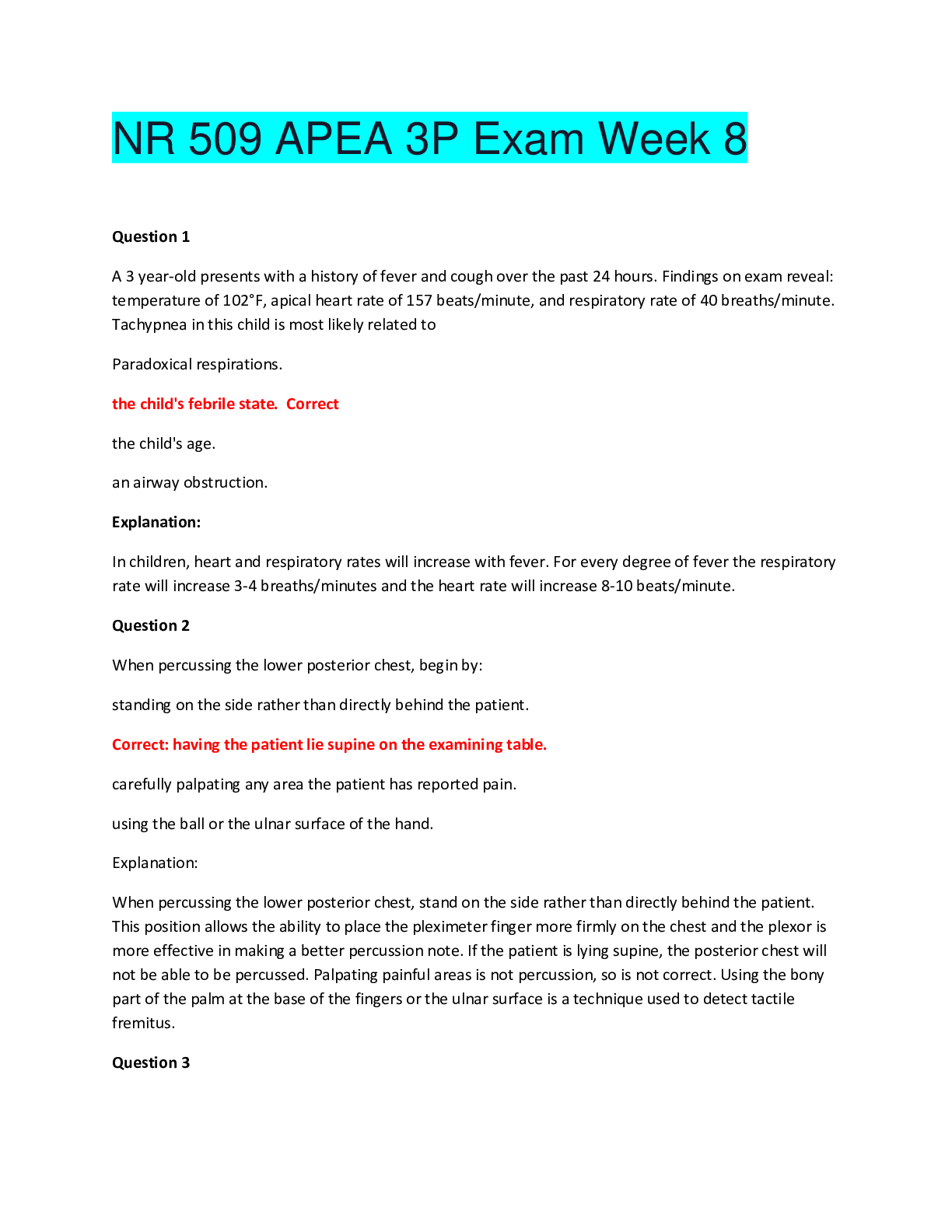
Buy this document to get the full access instantly
Instant Download Access after purchase
Add to cartInstant download
Reviews( 0 )
Document information
Connected school, study & course
About the document
Uploaded On
Oct 28, 2020
Number of pages
22
Written in
Additional information
This document has been written for:
Uploaded
Oct 28, 2020
Downloads
0
Views
124


